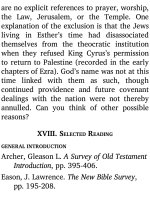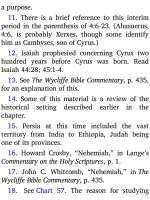Jensens survey of the old testament adam 195
Bạn đang xem bản rút gọn của tài liệu. Xem và tải ngay bản đầy đủ của tài liệu tại đây (117.33 KB, 4 trang )
(chaps. 40-66)
In this second division of the book,
comfort is the predominant note, although
there are repeated warnings to the wicked.
The discourses in this division are chie y
predictive. They fall into three groups of
nine chapters each. Read 48:22 and observe
the common utterance, ““no peace for the
wicked,’ says the LORD” which concludes
each of the first two groups (cf. 57:21).
The rst of the three groups (chaps. 4048) compares Jehovah, the true God, with
idols, the false gods. The second group
(chaps. 49-57) speaks almost entirely
concerning the Messiah. The third group
(chaps. 58-66) describes the nal restoration
of God’s people, with God on the throne
(66:1) acknowledged as Lord over all
(66:23).
Note also the following outline on the
B. COMFORT OF GOD
chart:
Redemption Promised
Redemption Provided
Redemption Realized
In your survey reading of Isaiah, try to
observe how the above outlines represent
the various sections. Study the other parts of
Chart 81 for what they contribute to an
understanding of the overall message of
Isaiah.
An easy way to remember the broad
organization of Isaiah by chapters is to note
these coincidental likenesses to the entire
Bible:
a) Isaiah has sixty-six chapters. The Bible has
sixty-six books.
b) Isaiah has two main divisions: the first, of
thirty-nine chapters; and the second, of
twenty-seven chapters. The Bible has
two main parts: the Old Testament, of
thirty-nine books; and the New
Testament, of twenty-seven books.
c) The prevailing note in the first division of
Isaiah is judgment; in the sedond division,
comfort. The prevailing note of the Old
Testament is Law; of the New Testament,
grace.
d) In the first section of Isaiah, there are
frequent allusions to and predictions of
the Messiah; but He is described with
great fullness in the second. In the Old
Testament there are frequent allusions to
Christ in types and prophecies; but in the
New Testament He is presented in all His
fullness.9
V. PROMINENT SUBJECTS
A. ISAIAH’S CALL TO THE PROPHETIC OFFICE
Isaiah must have received his call to the
prophetic o ce at an early age. He
describes the circumstances vividly in
chapter 6. Recall the similar experiences of
Moses (Exod 3) and Saul of Tarsus (Acts 9).
When God showed Himself in a vision to
these men, they recognized themselves as
vile, worthless creatures, with no power or
wisdom of their own. They surrendered to
God, and wholly committed themselves to
do His bidding, whatever it might be.
Isaiah’s words of consecration have been an
inspiration and challenge to multitudes of
God’s servants: “Here am I. Send me!” (6:8).
B. WARNING AND COMFORT
Isaiah, like most of the prophets, preached
a twofold message, as discussed earlier in
this chapter: warning of judgment for sin,
and comfort of salvation for righteousness.
In his book the two themes stand out in
bright contrast. John Phillips writes, “One









